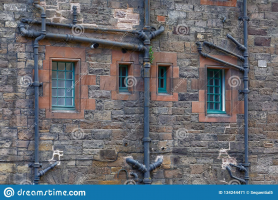SDS
REGISTERED
Single-family home built in 2012 under the IRC
The homeowner added an unpermitted 3rd story half bath...toilet and sink, sometime after the home was built. This toilet room is located on the inside of an exterior wall and they ran the waste line to the outside of the wall, then along the wall for about 20' (sloped) before it drops vertically down to tie into the underground sewer line. This line is fully exposed for it's entire length outside the building and they painted it with something the same color as the house.
There is a cleanout and a vertical vent line up at the toilet room end of the line...say, 16-18 feet up in the air. The vent line terminates just below the gable eaves. The homeowners would like to insulate it and soffit it into a protective enclosure rather than remove the half bath and drain line if possible.
P2603.5 Freezing states that plumbing lines shall not be installed outside the building unless adequate provisions are made to protect it from freezing, but it doesn't elaborate on minimum R-value required
The WSEC references min. duct insulation of R-8 as well as R-6 for mech piping, but I can't find any specific minimum for plumbing.
What would be an acceptable min. R-value for a plumbing drain line outside the building?
The homeowner added an unpermitted 3rd story half bath...toilet and sink, sometime after the home was built. This toilet room is located on the inside of an exterior wall and they ran the waste line to the outside of the wall, then along the wall for about 20' (sloped) before it drops vertically down to tie into the underground sewer line. This line is fully exposed for it's entire length outside the building and they painted it with something the same color as the house.
There is a cleanout and a vertical vent line up at the toilet room end of the line...say, 16-18 feet up in the air. The vent line terminates just below the gable eaves. The homeowners would like to insulate it and soffit it into a protective enclosure rather than remove the half bath and drain line if possible.
P2603.5 Freezing states that plumbing lines shall not be installed outside the building unless adequate provisions are made to protect it from freezing, but it doesn't elaborate on minimum R-value required
The WSEC references min. duct insulation of R-8 as well as R-6 for mech piping, but I can't find any specific minimum for plumbing.
What would be an acceptable min. R-value for a plumbing drain line outside the building?

